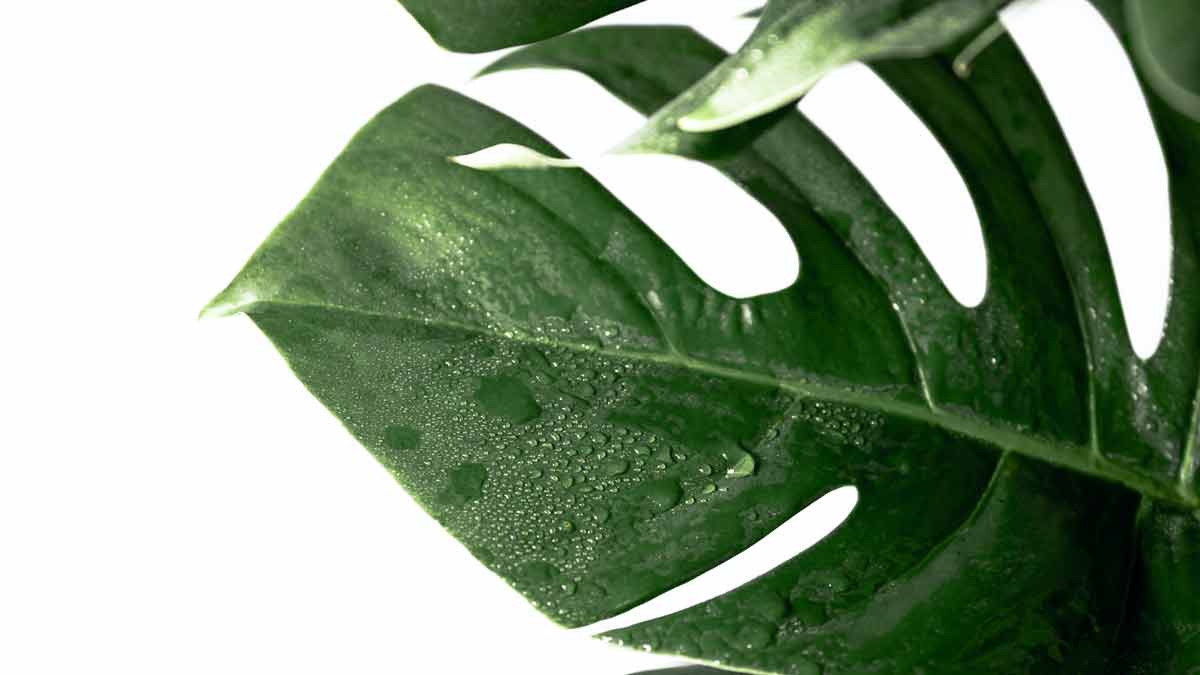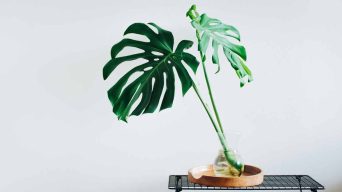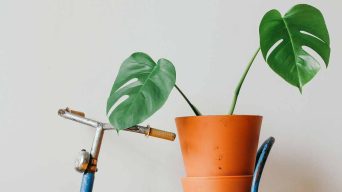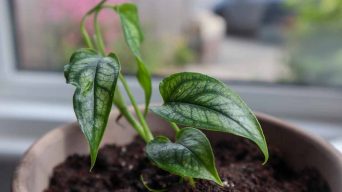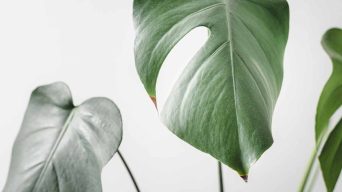Monstera leaves may drip water due to natural processes like transpiration and guttation, often caused by factors like dry air, high humidity, and overwatering. It’s usually normal, but maintain proper care to prevent issues like root rot or stress-related symptoms.
Monstera plants are known for their large, glossy leaves with distinctive holes or “windows” in them.
Some believe these holes help the plant breathe better in humid environments.
Monstera plants are relatively easy to care for but can be susceptible to several problems.
One common issue is that their leaves may start to drip water.
But why are your Monstera leaves dripping water?
A variety of factors can cause this.
Here, you will find all you need to know about why this happens and how to fix it.
Why Do Monstera Leaves Drip Water?
There are several reasons why Monstera leaves may start to drip water.
The most common reasons for leaves dripping water are transpiration and guttation.
What Is Transpiration in Plants?
Transpiration is the process of water vapor escaping from the leaves of a plant while its stomata are open. This usually happens when the air around the Monstera plant is dry.
The water vapor comes from the plant’s xylem, a tissue that transports water and nutrients from the roots to the leaves.
As the water vapor escapes from the leaves, it pulls more water up through the xylem. This helps to keep the plant hydrated and also cools it down.
This process is entirely normal and is how plants regulate their water levels.
Transpiration can lead to Monstera leaf dripping if the air around the indoor plant is very dry.
When the air is dry, the plant’s stomata will stay open for extended periods to get enough water vapor.
This can cause the leaves to lose too much water and start to drip.
This can be caused by several factors, including:
- Dry air: If the air around the plant is too dry, it will cause the plant to transpire more to keep itself hydrated.
- Hot weather: Hot weather can also cause plants to transpire more.
- Wind: Wind can also cause leaves to lose water vapor more quickly.
Can Transpiration Be Bad for Plants?
While transpiration is a normal and necessary process for plants, too much of it can indicate something is wrong.
If a Monstera plant is transpiring too much, it may be dehydrated. This can happen if the Monstera is not getting enough water or the air around it is too dry.
Dehydration can cause the Monstera leaves to turn brown and crispy. It can also cause the plant to stop growing.
If you think your Monstera is underwatered, you should try watering it more frequently. You may also need to mist the Monstera leaves with water to help increase the humidity around the plant.
You can also try using a humidity tray. This is a tray of water that you place underneath the pot.
The water will evaporate and help to increase the humidity around the Monstera plant.
Too much transpiration can happen if the roots cannot absorb water properly. This can be caused by several factors, including:
- Compacted soil: If the soil around the plant is compacted, it can prevent the roots from absorbing water.
- Root rot: Root decay is a common problem that can prevent roots from absorbing water properly.
If you think your plant’s roots are not absorbing water properly, you should try repotting it in fresh, loose soil.
How to Reduce Transpiration
There are a few things you can do to reduce transpiration.
The first is to make sure the plant is getting enough water. If the plant’s roots do not receive enough water, the leaves will lose moisture to try to get more.
Make sure you are watering your Monstera plant regularly and deeply.
The second is to increase the humidity around the Monstera plant. You can do this by misting the leaves or placing the pot on a pebble tray.
A pebble tray is a tray of water with pebbles in it. The water will evaporate and increase the humidity around the plant.
You can also use a humidifier.
The third is to reduce the amount of wind around the plant. If the leaves lose water too quickly, they will start dripping water.
To reduce the amount of wind, you can move your Monstera to a more sheltered location or put it behind a screen or curtain.
What Is Guttation in Plants?
Guttation is the process of water droplets forming on the leaves of a plant.
It happens when the plant’s roots absorb more water than the leaves can use.
The excess water is then excreted from the leaves as droplets.
The water droplets may be transparent or tinted with green, and they can appear on the tips or margins of the leaves.
Guttation is most likely to occur in the morning or evening when the air is cooler, and the plant’s transpiration rate is low.
Guttation can also be caused by high humidity, which can cause the Monstera to take in more water than it needs and start dripping water.
In most cases, guttation is not a cause for concern. It is a normal process that helps plants regulate their water intake.
Guttation can be caused by several factors, including:
- High humidity: If the air around the plant is too humid, it will absorb more water than it needs.
- Overwatering: Overwatering can also cause guttation. If the roots are sitting in water, they will take in too much, and the plant will release it through its leaves.
- Fertilizer: If the plant gets too much fertilizer, it can cause guttation. The high levels of nutrients can cause the plant to take in more water than it needs.
Can Guttation Be Bad for Plants?
Guttation is not usually harmful to plants.
However, in some cases, it can be a sign that the Monstera is under stress.
This can happen if the Monstera is overwatered or the air is too humid.
Frequent occurrences of guttation can lead to the browning or yellowing of Monstera leaves. It can also lead to leaf drop.
It is essential to check the roots to ensure they are not rotting.
Excess water can cause the roots to rot, which can be fatal for the plant.
Difference Between Guttation and Dew
Guttation and dew are often confused because they both cause water droplets to form on plant leaves.
However, there are a few key differences between the two.
Dew is formed when the air around the plant cools down, and the water in the air condenses on the leaves.
Guttation, on the other hand, is caused by the indoor plant itself.
The water droplets in guttation are excreted from the plant’s leaves, whereas dew is water from the air condensed on the leaves.
Guttation is more common in the morning or evening when the air is cooler, and the plant’s transpiration rate is low.
Dew can form at any time but is more likely to occur in the morning when the air is cool, and the plant’s leaves are still wet from overnight watering.
Guttation is a normal process that helps plants regulate their water intake. Dew is simply condensation and is not harmful to the plant.
What Can I Do About Monstera Leaves Dripping Water?
There is no need to worry if you see water droplets on your Monstera leaves.
Guttation is a normal process that helps plants regulate their water intake.
However, if the Monstera shows other signs of overwatering and root rot, you may need to take action.
Here are a few things you can do to prevent guttation:
1. Water Your Monstera Deeply and Less Frequently
If you water your Monstera deeply and less frequently, the roots will have a chance to dry out between waterings.
This will help prevent waterlogging and root rot.
Monstera plants need to be watered about once a week.
Make sure the soil is dry before you water it again.
Water in the morning, so the plant has time to absorb the water before the sun sets.
2. Increase the Airflow Around the Plant
If the air around the plant is too humid, it can cause guttation.
Increase the airflow by opening windows or using a fan.
You can also put the plant in a room with an air conditioner.
3. Ensure the Soil Is Well-Draining
If the soil is too wet, it can cause waterlogging.
Make sure the potting mix you use for your Monstera is well-draining.
You can add perlite or sand to improve drainage.
4. Make Sure the Pot Has Drainage Holes
The roots will sit in water and rot if the pot doesn’t have drainage holes.
Make sure the pot you use for your Monstera has at least one drainage hole so the excess water can drain out.
If it doesn’t, you can drill one yourself.
5. Cut Back on Fertilizer
If you are fertilizing your Monstera, ensure you are not using too much.
Too much fertilizer can cause guttation.
Use a balanced fertilizer diluted to half the strength recommended on the package.
Only fertilize your plant every other month.
6. Avoid Overwatering
Overwatering is the most common cause of guttation.
To avoid overwatering, only water your Monstera when the soil is dry.
Stick your finger in the soil to check before watering.
If the soil is dry, water the plant until the water comes out of the drainage holes.
If the soil is still wet, wait a few more days before watering.
7. Move the Plant to a Cooler Location
If the air around the Monstera is too humid, it can cause guttation and the plant to start dripping water.
Move the plant to a cooler location with good airflow.
You can also put it in a room with an air conditioner.
8. Check the Roots
If you see water droplets on the leaves, check the roots to ensure they are not rotting.
Rotting roots can lead to waterlogging, which can be fatal for plants.
To check the roots, carefully remove the Monstera from its pot.
Examine the roots and look for signs of decay.
If you see any, trim off the affected roots and repot the plant in fresh soil.
9. Remove Affected Leaves
When you notice that guttation has caused the Monstera leaves to turn yellow or brown, it’s time to take action by pruning these affected leaves.
To do this, equip yourself with a sharp knife or scissors and carefully snip off the problematic leaves right at the base of the Monstera plant. This not only helps maintain the overall health and appearance of your plant but also prevents further issues from developing.
10. Be Patient
If you have just watered your Monstera, it may take a few hours to absorb the water.
Do not water the plant again until the soil is dry.
Once the plant has had a chance to adjust to its new environment, leaf dripping should stop.
Final Thoughts
Leaf dripping is a perfectly normal phenomenon in Monsteras.
If your houseplant is otherwise healthy and happy, there’s no need to worry about the water droplets.
However, if you notice that your plant is losing more water than usual, you should check for signs of stress, such as wilting leaves or discoloration.
If you think your Monstera is stressed, try to identify the cause and take steps to correct it.
Common causes include too much or too little water, low humidity levels, and temperature stress.
Taking good care of your Monstera can help it stay healthy and prevent leaf dripping.

